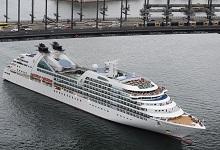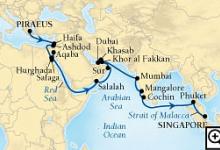Recently Viewed Cruises
- Odyssey, Monuments of Antiquity ex Athens to SingaporeAdd to favourites
- Odyssey, Aegean Isles & Sacred Sites ex Istanbul to DubaiAdd to favourites
- Legend, Empires & Antiquities ex Rome to DubaiAdd to favourites
- Odyssey, To the Orchid Isles ex Istanbul to SingaporeAdd to favourites
- Odyssey, Golden Aegean & Sacred Sites ex Athens to DubaiAdd to favourites
- Royal Caribbean International raises the bar
- Classy Astor fills gap in market
- Oceanic Discoverer
- Ab Fab Oosterdam
- Catch up on Cruising: Latest cruise news in bite size
- Frequently Asked Questions
-
Odyssey, Monuments of Antiquity ex Athens to Singapore
Nights 34 Ship Seabourn Odyssey Star Rating 
Departs Athens (Piraeus) Greece Sailing 2013: 12 Oct Ports of Call Athens (Piraeus) Greece, Haifa, Ashdod (Jerusalem), Suez Canal, Hurghada, Aqaba, Safaga (Luxor), Salalah More Sur, Dubai, Khasab, Fujairah, Mumbai (Bombay), Mangalore, Cochin (Kochi), Phuket, Singapore Please enquire about this cruise for pricing.


34 Night Cruise sailing from Athens to Singapore aboard Seabourn Odyssey.
Seabourn Odyssey is the first in a new-class of ships for Seabourn that will accommodating just 450 guests in 225 luxury suites. Although, at 32,000 GRT, Seabourn Odyssey is more than triple the size of Seabourn Pride, Seabourn Spirit and Seabourn Legend, she was the smallest new ship being built by any major cruise line, and her guest capacity is just twice that of the smaller sisters, creating the highest space-per-guest ratio in the industry.
Highlights of this cruise:
Piraeus (Athens), Greece
Piraeus has been the port for Athens since 482 BC. The busy harbor is filled with ferries and cruise ships making their way to the Greek Islands and other Mediterranean cities. The busy metropolis of Athens and its treasure trove of antiquities lie just a few miles from the port. Even as the reality of the modern city took hold, with its high-rise apartments, crowded sidewalks and bustling traffic, the beauty of the Acropolis, the outstanding museums, charming cafes, sidewalk markets and startling views come together in a cultural mosaic for all to enjoy.
Haifa
Situated on the slopes of Mount Carmel, along one of the most beautiful bays on the Mediterranean coast, Haifa is Israel's primary port. It also serves as an important gateway to the biblical and historical sites of this sacred land. Although the origin of Haifa is obscure, its name appears for the first time in the 3rd century A.D. in Talmudic literature. Over the years, Crusaders, Arabs, Turks and the British occupied the city. Today, this bustling city possesses the nation's largest industries, several important museums and the respected Haifa Technical Institute. It is also the world center of the Baha'i faith, symbolized by a beautiful gold-domed shrine.
Ashdod (Jerusalem)
The largest port in Israel, Ashdod is a gateway to Jerusalem, the 5,000-year-old walled city that is considered sacred to more than a third of the people on Earth. Numerous sites exist nearby, including the Jewish sacred Western Wall, and the Church of the Holy Sepulchre said to be the site of Calvary and to contain a piece of the true cross.
Meander along the seaside promenade, or dip your toes in the Dead Sea waters, long known for their health benefits. Visit the Bar-Gera Museum to view a collection of art by artists who were either banned or persecuted by the Nazis and other fascist governments. The Yad Vashem Memorial Museum is dedicated to the six million Jews who lost their lives during the Holocaust.
Suez Canal
Aqaba
Aqaba is a sleepy fishing village with a long and historic past. At various times, the port was a stopover on ancient caravan routes, a garrison for Roman troops and meeting place for pilgrims en route to Mecca. Recent excavations have revealed a third-century church, one of the worlds oldest. In medieval times, Aqaba was an important part of Palestine before being absorbed into the Ottoman Empire, a time when Lawrence of Arabia figured in local history. Today Aqaba is important as Jordan's only deep water port and the jumping-off point for excursions to Petra, the country's premier historical attraction.
Safaga
Located on the Egyptian side of the Red Sea, the port of Safaga is the gateway to some of Egypt's most memorable destinations: Luxor, Karnak and Thebes. Luxor has often been called the world's greatest open-air museum, and the number and preservation of the monuments in the area are unparalleled anywhere else in the world. The ancient Egyptians called Luxor "The City" and Homer called it the "City of a Thousand Gates." The troops of Napoleon, coming upon its grandeur, broke into spontaneous applause. The pharaoh's tombs in the Valley of the Kings, and the colossal temples of Luxor and Karnak capture the imagination with splendors that have survived the centuries.
Salalah
Salalah, Oman's ancient incense capital is an oasis with lush vegetation resulting from seasonal monsoons. The city's roads wind through groves of coconut, papaya and banana trees, and roadside stands sell fresh fruit and coconut water. The tropical atmosphere is a striking contrast to the otherwise arid landscapes of the Arabian Peninsula. Even the Queen of Sheba fell under the spell of the area's treasure far greater than gold, and sent gifts of frankincense to impress Solomon. Today, the beautiful sand beaches, cultural history, archaeology and natural diversity draw visitors to this ancient paradise.
Dubai
The United Arab Emirates is strategically located at the crossroads of East and West, and the traditional trading routes from Asia and the Far East to Europe and further afield are even more significant today than they were hundreds of years ago. Nestled at the very heart of the Islamic world, the country is unique in its embrace of the Western world. Here you can see the contrasts of the nomadic Bedouin people, and the opulence and splendor of the Sheiks, set against a backdrop of Western lifestyles.
Khasab
With a rugged coastline slashed by narrow fjords, Oman's Musandam Peninsula is often called the ""Norway of Arabia."" Separated from the rest of the Sultanate of Oman by the United Arab Emirates, the peninsula is a rocky headland jutting into the Strait of Hormuz, forming one of the most strategic shipping lanes in the world. Along the scenic east coast, native dhows ply the waters where spinner and bottlenose dolphins are often seen. Ancient towns such as Khasab, the capital of the region, and Bukha offer centuries-old forts and a compelling glimpse into the essence of Arabia.
Mumbai
Mumbai (formerly called Bombay) is a captivating city, known for its striking contrasts. The fastest growing, most affluent and industrialized city in India, Mumbai represents the ever-changing face of today's India: the old coupled with the dynamic new. This vibrant city is a kaleidoscopic mixture of intriguing people and incredible places, where within a block or two you can find modern skyscrapers, ornate Victorian buildings, and bustling bazaars.
Mangalore
Long one of India's most important ports, Mangalore still ships three-quarters of India's coffee production and a third of its cashew crop. Occupied by the Portuguese shortly after its discovery by Vasco da Gama, it later thrived under British colonial occupation. Catholicism took root here and two local churches, the richly decorated St. Aloysius College Chapel and the simpler Milagres Church are a testament to its continuing influence. Nearby, at the foot of Kadri hill, is the Hindu Kadri Manjunatha Temple, with a bronze statue of Lokeshwara considered to be one of India's finest.
Phuket
Phuket, nestled in the balmy Andaman Sea waters, lies 536 miles south of Bangkok. Initially, Phuket derived its wealth from tin and rubber, and enjoyed a rich and colorful history. Located on a major trade route between India and China, Phuket was frequently mentioned in foreign trader's ship logs. Blessed with a natural heritage of stunning white-sand beaches, sapphire blue seas, exotic marine life and lushly forested hillsides, Phuket is one of Southeast Asia's most popular destinations.
Singapore
Founded as a British trading colony in 1819, Singapore joined the Malaysian Federation in 1963. Two years later, it became an independent island-state, developing into one of the world's most prosperous countries. With ultra-modern skyscrapers combined with a medley of Chinese, Indian and Malay influences, Singapore is a dynamic city rich in contrast and color, exhibiting a harmonious blend of culture, cuisine, arts and architecture.





